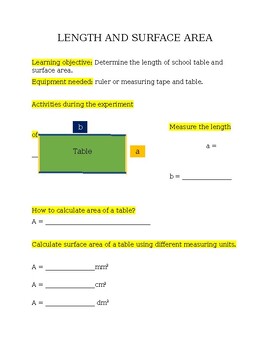Worksheet: Length and surface area
EduMateja
2 Followers
Resource Type
Standards
CCSS5.MD.A.1
CCSS5.G.A.1
CCSS5.G.A.2
CCSS6.RP.A.3d
CCSSRST.6-8.3
Formats Included
- Word Document File
Pages
3 pages
EduMateja
2 Followers
Description
Worksheet: length and surface area can help students to practice how to measure length and how to calculate area. Also, this worksheet include few task to check if students understand how to convert between measuring units (mm, cm, dm, km). On the second page is marking rubric for teacher and on the last page is example of how answers should look like.
Total Pages
3 pages
Answer Key
Included with rubric
Teaching Duration
45 minutes
Last updated 10 months ago
Report this resource to TPT
Reported resources will be reviewed by our team. Report this resource to let us know if this resource violates TPT’s content guidelines.
Standards
to see state-specific standards (only available in the US).
CCSS5.MD.A.1
Convert among different-sized standard measurement units within a given measurement system (e.g., convert 5 cm to 0.05 m), and use these conversions in solving multi-step, real world problems.
CCSS5.G.A.1
Use a pair of perpendicular number lines, called axes, to define a coordinate system, with the intersection of the lines (the origin) arranged to coincide with the 0 on each line and a given point in the plane located by using an ordered pair of numbers, called its coordinates. Understand that the first number indicates how far to travel from the origin in the direction of one axis, and the second number indicates how far to travel in the direction of the second axis, with the convention that the names of the two axes and the coordinates correspond (e.g., 𝘹-axis and 𝘹-coordinate, 𝘺-axis and 𝘺-coordinate).
CCSS5.G.A.2
Represent real world and mathematical problems by graphing points in the first quadrant of the coordinate plane, and interpret coordinate values of points in the context of the situation.
CCSS6.RP.A.3d
Use ratio reasoning to convert measurement units; manipulate and transform units appropriately when multiplying or dividing quantities.
CCSSRST.6-8.3
Follow precisely a multistep procedure when carrying out experiments, taking measurements, or performing technical tasks.





